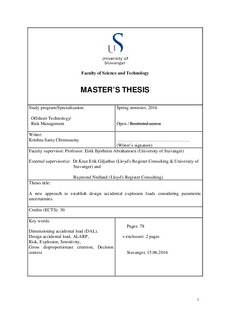| dc.contributor.author | Chinnusamy, Krishnasamy | |
| dc.date.accessioned | 2016-09-16T10:31:49Z | |
| dc.date.available | 2016-09-16T10:31:49Z | |
| dc.date.issued | 2016-06-15 | |
| dc.identifier.uri | http://hdl.handle.net/11250/2407773 | |
| dc.description | Master's thesis in Offshore Technology / Risk management | nb_NO |
| dc.description.abstract | The Norwegian risk management approach for offshore installations requires that risk analysis shall provide a basis for making decision on the design accidental load that shall be used in the design to avoid major accident risk. One of the major risks on offshore installations is explosion risk. An explosion involves interaction of many variable uncertain parameters. Explosion risk assessment is a complex process which involves a range of analyses with uncertainties. As a part of risk analysis, dimensioning accidental load for explosion is determined using a probabilistic explosion assessment as described by NORSOK Z-013 and comparing the results with applicable risk acceptance criteria. Dimensioning accidental loads determined as above provides decision support in establishing design accidental loads that are considered to be valid throughout the installations lifetime.
Design accidental loads are established in the early phase of the project. A decision needs to be taken at the initial phase of the project where sufficient information to determine the real picture is not available. Currently no clear guidance exists in the industry on how the design accidental loads are selected based on DAL determined by the risk analysis.
Different views exists across the industry whether to consider modifications into account in establishing design accidental load. The influence of minor modifications on DAL during the operational phase is discussed. Minor modification projects, not individually considered to have significant impact on the total risk level, but together and over time result in significant increase in risk level.
Petroleum safety authority’s updated definition for risk as “the consequences of the activities, with associated uncertainty” demands increased focus in the way the uncertainty is presently handled in the risk analysis. Current offshore risk assessment process uses (A, C, P) perspective and describes risk using probabilities and expected values for the decision making and no account for the uncertainties hidden in the analyst's background knowledge is given. This may bring surprises when the knowledge used in the analysis is weak.
The decisions following this approach and comparing with risk acceptance criterion may lead to accept the results irrespective of its robustness. This means a lean disproportionate weight is given to further risk reduction process like ALARP (As Low As Reasonably Practicable). Safety decision contexts require different decisions with respect to uncertainties. In case of high uncertainties measures following cautionary principle are normally implemented.
In reducing the risk beyond minimum acceptance criterion following ALARP, current practice uses cost-benefit analysis where a single grossly disproportionate criterion is used for all decision contexts. This way the ALARP principle turns out to be static. To be an appropriate principle in safety context, ALARP should be dynamic in the sense that ranges from one extreme, where decisions are made following only cost benefit analysis in some decision contexts, to another, in which the cautionary principle is adopted with no reference to cost-benefit analyses for others.
A new method to achieve an improved decision on design accidental explosion load with some changes in the current practice to comply with risk reduction principles outlined in in the Framework regulations §11 is established. This method follows (A, C, U) perspective that holds uncertainty as a main component of risk and use both risk acceptance criteria and ALARP principle in establishing design accidental explosion loads taking uncertainties. In the suggested approach probabilities are only considered as tools that describe the epistemic-based uncertainty factors i.e. factors that could cause surprises relative to the assigned probabilities and expected values. The uncertainty factors related to the applied knowledge will be identified and assessed for its influence on the total risk following a semi-quantitative method. In addition to the uncertainty factors assessment, guidelines need to be established by the decision maker to decide the decision context that shall be applied to implement ALARP.
The suggested method is expected to improve the ALARP by making it dynamic and optimise the margins in the design accidental loads by uncertainty analysis of the parameters. The method is elaborated in detail for a decision problem related to explosion event and a case study is presented wherein the principles of the suggested method is applied. | nb_NO |
| dc.language.iso | eng | nb_NO |
| dc.publisher | University of Stavanger, Norway | nb_NO |
| dc.relation.ispartofseries | Masteroppgave/UIS-TN-IØRP/2016; | |
| dc.rights | Navngivelse 3.0 Norge | * |
| dc.rights.uri | http://creativecommons.org/licenses/by/3.0/no/ | * |
| dc.subject | ALARP | nb_NO |
| dc.subject | dimensioning accidental load (DAL) | nb_NO |
| dc.subject | design accidental load | nb_NO |
| dc.subject | risk management | nb_NO |
| dc.subject | risk | nb_NO |
| dc.subject | explosion | nb_NO |
| dc.subject | sensitivity | nb_NO |
| dc.subject | gross disproportionate criterion | nb_NO |
| dc.subject | decision context | nb_NO |
| dc.subject | offshore technology | nb_NO |
| dc.title | A new approach to establish design accidental explosion loads considering parametric uncertainties | nb_NO |
| dc.type | Master thesis | nb_NO |
| dc.subject.nsi | VDP::Technology: 500::Marine technology: 580::Offshore technology: 581 | nb_NO |

